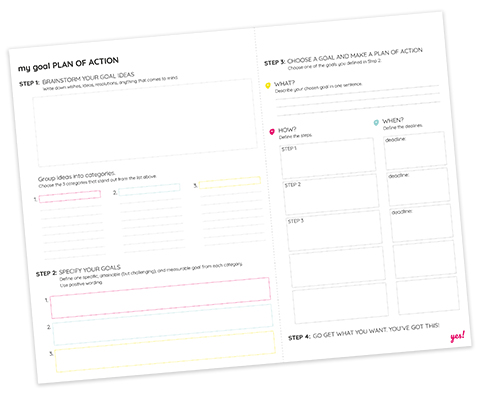
I strongly believe that knowing what you want in life is the first step to getting there. When you don’t know what you are striving for it is only natural to feel lost. You start to question your every move and at the same time feel like you are going nowhere. That’s a terrible place to be (I speak from experience).
This is why learning how to set goals and achieve them is such an important life lesson. It’s something they don’t teach us at school but is so crucial to success.
Research even shows that setting goals makes us more likely to achieve what we want. And it makes complete sense. When you know what you are striving for and have a plan of how to achieve it, you become much more efficient in getting there.
In this article, we are going to take a closer look at the first step – setting goals. We’ve also included a free printable (you’ll find it at the end of the article) to help you put what you learn here today into action.
If you feel like you already got this and want to read about how to achieve your goals, you can skip to the next article in this series How to Set Goals and Achieve Them – PART 2: achieving goals. Otherwise, read on.
![]()
Defining your goals
The first step to achieving the desired results is wise and deliberate goal-setting. It may sound straight-forward, but setting the right goals is crucial for your success.
What is a goal?
Let’s first take a look at what a goal is not. A goal is not a resolution. It is easy to make a resolution (especially around New Year’s when we all think about our new and improved selves). A resolution is merely a wish, it is an idea of what you would like to have or accomplish. However, with a resolution, you don’t think about how you are going to achieve it. A resolution by its nature is passive.
A goal, on the other hand, is active. It is a decision about what you want to accomplish with a plan of how you are going to get there. See the difference?
It is fine to make resolutions, as they can often serve as the big picture, the big reason why you are doing something. However, to actually get to success, you must transform those passive resolutions into active goals.
![]()
How to define your goals?
Step 1
Brainstorm your goals ideas.
If you don’t have a clear idea of what your goals are yet, I suggest you take a piece of paper and write down anything that comes to mind. These can be ideas, resolutions or actual goals. At this point, they don’t have to be super thought-out.
Next, try grouping them into categories. For example, you could have categories like health, work, and family.
Once they are grouped some of your initial ideas may seem similar to others. This is fine, it means you are thinking about certain goals from different angles. For clarity, cross out the ones that seem repeated.
This short exercise should give you an idea of which areas of your life you want to work on. However, as we saw earlier, these still aren’t real goals. To get there, you have to be more specific.
Step 2
Specify your goals.
This is the step where you make the passive ideas become active. Going through one category at a time, write down your goals.
Your goals should be:
– Specific
Describe precisely what it is you want to achieve. For example, instead of saying My goal is to be more creative write My goal is to do at least one DIY project per week. Defining specific goals will make you feel more in control of the process. Moreover, it makes it more likely for you to actually achieve the desired result.
– Attainable, but challenging
If you define a goal that is impossible for you to achieve, you are setting yourself up for failure. Set realistic and attainable goals, but at the same time make sure they challenge you in one way or another. This will keep you from getting bored too soon and will make achieving your goals that much sweeter.
Setting attainable goals also means only writing down goals that rely solely on your actions. You cannot control how other people act and your goals should reflect that.
– Measurable
If possible, define goals that can somehow be measured. For example, if you want to improve your writing skills, your goal should sound something like My goal is to write 500 words every day. Defining the exact number of words will make it harder for you to slack off.
Define your goals with positive wording
As you write your goals down, use positive wording. Don’t define what you want less of. Instead, write what you want more of, what you are striving for.
For example, instead of saying My goal is to spend less time on social media think about what you want to do instead. Maybe something like My goal is to read one book per week.
Step 3
Make a plan of action.
A goal is not a goal unless you have a plan of action. Naturally, the complexity of the plan depends on the type of goal you have set. However, there are certain elements that your plan should have regardless of how intricate the goal is.
Set a deadline
First, define your deadline. This is the exact date by which you will attain your goal. Be realistic and specific.
If your goal is very long-term, which means it will take you more than about 2 months to achieve it, you should divide it into smaller sub-goals. Then define deadlines for each of the sub-goal individually.
The exception here is a habit changing goal (like drink 8 glasses of water a day). You don’t need a deadline here, because you can (and should) start doing that immediately.
Write a to-do list
Next, write the list of tasks that you need to do in order to achieve your goals. Again, depending on your goal this could be a very short list or a very long one. Either way, try to think of all the necessary steps and try to predict possible setbacks.
This is probably the hardest part of the planning and may take quite a lot of time. Don’t worry about that. Instead, make sure you think everything through with the information you currently have. As you move towards realizing your goals, you might need to adjust the to-do list. That is completely normal and is an important part of the process.
Measure progress
Finally, define how you are going to measure your progress. For example, if I want to drink 8 glasses of water a day, a water drinking tracking app or a printable tracker would be a good choice.
For more complex goals think about the most sensible way to measure progress. Would making a spreadsheet be helpful? Or maybe a weekly planner would do the trick?
![]()
Congratulations! If you have gone through all the three steps, you have got yourself a goal. It sounds easy, but it really is the first and crucial step to getting what you want from life.
Now you can move on to the next step, which is how to achieve your goals. We will take a look at this in part 2 of this article: How to set goals and achieve them – PART 2: achieving goals.
If you’re serious about this, download our free printable below. It will help you go through the steps I I’ve just talked about and set some meaningful goals for your future.
And don’t forget to let us know what you think! Are you good at setting goals? Do you do it regularly? And do you have any other tips on how to define goals to set yourself for success? Please share in the comments!

Download your free printable:
my goal PLAN OF ACTION
Fill out the form below to get the download link.
